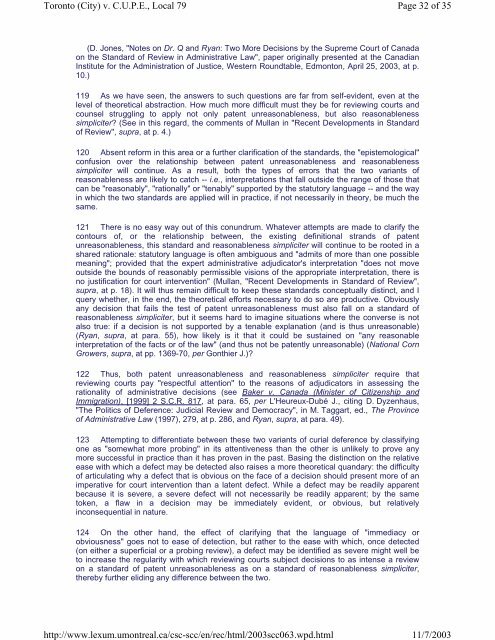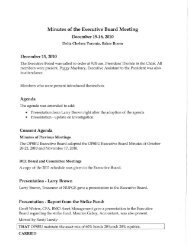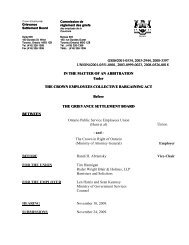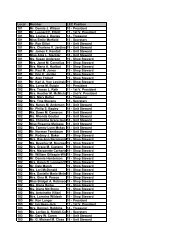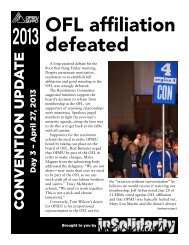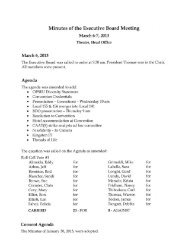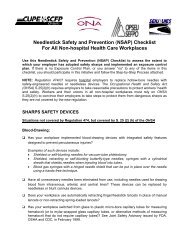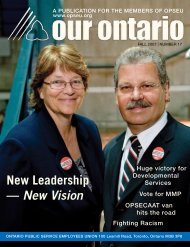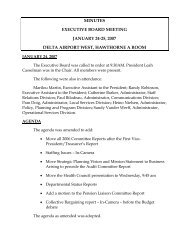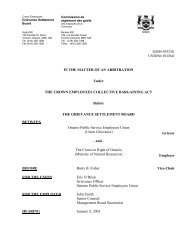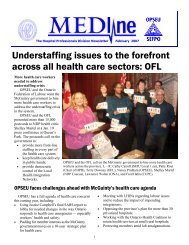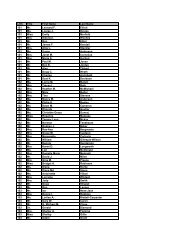C.U.P.E., Local 79 v. Toronto (City) .pdf - OPSEU
C.U.P.E., Local 79 v. Toronto (City) .pdf - OPSEU
C.U.P.E., Local 79 v. Toronto (City) .pdf - OPSEU
You also want an ePaper? Increase the reach of your titles
YUMPU automatically turns print PDFs into web optimized ePapers that Google loves.
<strong>Toronto</strong> (<strong>City</strong>) v. C.U.P.E., <strong>Local</strong> <strong>79</strong><br />
http://www.lexum.umontreal.ca/csc-scc/en/rec/html/2003scc063.wpd.html<br />
Page 32 of 35<br />
11/7/2003<br />
(D. Jones, "Notes on Dr. Q and Ryan: Two More Decisions by the Supreme Court of Canada<br />
on the Standard of Review in Administrative Law", paper originally presented at the Canadian<br />
Institute for the Administration of Justice, Western Roundtable, Edmonton, April 25, 2003, at p.<br />
10.)<br />
119 As we have seen, the answers to such questions are far from self-evident, even at the<br />
level of theoretical abstraction. How much more difficult must they be for reviewing courts and<br />
counsel struggling to apply not only patent unreasonableness, but also reasonableness<br />
simpliciter (See in this regard, the comments of Mullan in "Recent Developments in Standard<br />
of Review", supra, at p. 4.)<br />
120 Absent reform in this area or a further clarification of the standards, the "epistemological"<br />
confusion over the relationship between patent unreasonableness and reasonableness<br />
simpliciter will continue. As a result, both the types of errors that the two variants of<br />
reasonableness are likely to catch -- i.e., interpretations that fall outside the range of those that<br />
can be "reasonably", "rationally" or "tenably" supported by the statutory language -- and the way<br />
in which the two standards are applied will in practice, if not necessarily in theory, be much the<br />
same.<br />
121 There is no easy way out of this conundrum. Whatever attempts are made to clarify the<br />
contours of, or the relationship between, the existing definitional strands of patent<br />
unreasonableness, this standard and reasonableness simpliciter will continue to be rooted in a<br />
shared rationale: statutory language is often ambiguous and "admits of more than one possible<br />
meaning"; provided that the expert administrative adjudicator's interpretation "does not move<br />
outside the bounds of reasonably permissible visions of the appropriate interpretation, there is<br />
no justification for court intervention" (Mullan, "Recent Developments in Standard of Review",<br />
supra, at p. 18). It will thus remain difficult to keep these standards conceptually distinct, and I<br />
query whether, in the end, the theoretical efforts necessary to do so are productive. Obviously<br />
any decision that fails the test of patent unreasonableness must also fall on a standard of<br />
reasonableness simpliciter, but it seems hard to imagine situations where the converse is not<br />
also true: if a decision is not supported by a tenable explanation (and is thus unreasonable)<br />
(Ryan, supra, at para. 55), how likely is it that it could be sustained on "any reasonable<br />
interpretation of the facts or of the law" (and thus not be patently unreasonable) (National Corn<br />
Growers, supra, at pp. 1369-70, per Gonthier J.)<br />
122 Thus, both patent unreasonableness and reasonableness simpliciter require that<br />
reviewing courts pay "respectful attention" to the reasons of adjudicators in assessing the<br />
rationality of administrative decisions (see Baker v. Canada (Minister of Citizenship and<br />
Immigration), [1999] 2 S.C.R. 817, at para. 65, per L'Heureux-Dubé J., citing D. Dyzenhaus,<br />
"The Politics of Deference: Judicial Review and Democracy", in M. Taggart, ed., The Province<br />
of Administrative Law (1997), 2<strong>79</strong>, at p. 286, and Ryan, supra, at para. 49).<br />
123 Attempting to differentiate between these two variants of curial deference by classifying<br />
one as "somewhat more probing" in its attentiveness than the other is unlikely to prove any<br />
more successful in practice than it has proven in the past. Basing the distinction on the relative<br />
ease with which a defect may be detected also raises a more theoretical quandary: the difficulty<br />
of articulating why a defect that is obvious on the face of a decision should present more of an<br />
imperative for court intervention than a latent defect. While a defect may be readily apparent<br />
because it is severe, a severe defect will not necessarily be readily apparent; by the same<br />
token, a flaw in a decision may be immediately evident, or obvious, but relatively<br />
inconsequential in nature.<br />
124 On the other hand, the effect of clarifying that the language of "immediacy or<br />
obviousness" goes not to ease of detection, but rather to the ease with which, once detected<br />
(on either a superficial or a probing review), a defect may be identified as severe might well be<br />
to increase the regularity with which reviewing courts subject decisions to as intense a review<br />
on a standard of patent unreasonableness as on a standard of reasonableness simpliciter,<br />
thereby further eliding any difference between the two.


